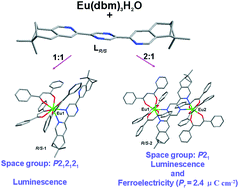Two mono- and dinuclear Eu(iii) enantiomeric pairs based on chiral bis-bidentate bridging ligands: synthesis, structures, luminescent and ferroelectric properties†
Abstract
Using the enantiomeric bis-bidentate bridging ligands (+)/(−)-2,5-bis(4,5-pinene-2-pyridyl)pyrazine (LS/LR) and depending on the ratio control of reactants, two mono- and dinuclear Eu(III)-based enantiomeric pairs with the formulae Eu(dbm)3LR/S·2H2O (LR in R-1, LS in S-1 and dbm = dibenzoylmethanato) and Eu2(dbm)6LR/S·H2O (LR in R-2 and LS in S-2) have been stereoselectively synthesized and structurally characterized. The circular dichroic (CD) spectra confirmed their chiroptical activities and enantiomeric natures. The homochiral dinuclear species represents the first example of a polynuclear lanthanide β-diketonate complexes with circular dichroic and crystallographic evidences. The photoluminescent properties studies revealed that both mono- and dinuclear Eu(III) complexes exhibited the characteristic red emissions of Eu(III) ions in the solid state (at 77 K and 300 K) and CH2Cl2 solution. Notably, the photophysical properties of the mononuclear enantiomers were superior to the dinuclear species. Interestingly, R-2 displayed a ferroelectric property at room temperature, which was not observed for R-1 due to the lack of crystalline polarity. R/S-2 are the first examples of homochiral polynuclear lanthanide complexes with luminescence and ferroelectric properties, being potential multifunctional materials.


 Please wait while we load your content...
Please wait while we load your content...